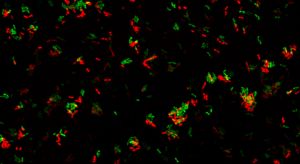- La formación de consorcios permite a las comunidades bacterianas mejorar su supervivencia, y esta característica tiene un alto interés en el desarrollo de consorcios artificiales con aplicaciones industriales
- Un equipo de investigadores del CNB-CSIC describe una nueva metodología para caracterizar la composición de este tipo de agregados bacterianos.
En la naturaleza, algunos microorganismos (bacterias y hongos) forman estructuras biológicas con un alto grado de organización estructural y capacidad de albergar comunidades formadas por múltiples especies distintas. Estas son denominadas formalmente biopelículas (biofilms). Dichas comunidades microbianas poseen una alta capacidad de sobrevivir en el medioambiente en el que habitan: se protegen mediante la secreción de complejos cócteles químicos que las permiten adherirse fuertemente a superficies y tejidos, así como resistir mucho más cualquier agresión externa. Además, pueden producirse acciones simbióticas/cooperativas entre las diferentes especies de microorganismos que les permitan mejorar su supervivencia compartiendo nutrientes y especializándose cada una de las especies en la realización de funciones esenciales para el consorcio.
Esta característica observada en los consorcios microbianos puede ser de gran interés en biotecnología, donde la utilización de técnicas de ingeniería y biología sintética podría habilitar la explotación de sus características para el desarrollo de aplicaciones industriales (como por ejemplo la producción de sustratos enzimáticos o la descontaminación de aguas residuales).
Uno de los retos del desarrollo de estos nuevos consorcios artificiales es la caracterización de su estructura y de la heterogeneidad de su composición mediante parámetros cuantificables. Investigadores del Consejo Superior de Investigaciones Científicas liderados por Víctor de Lorenzo en el Centro Nacional de Biotecnología (CNB-CSIC) publican ahora en la revista Water Research una nueva metodología basada en el uso de parámetros que analizan la composición y morfología de los agregados de manera precisa.
David R. Espeso, primer autor del trabajo, explica “hasta ahora, la manera de medir estos agregados era a través de parámetros simples como la velocidad de sedimentación o su diámetro, que no permiten caracterizar la complejidad y diversidad presentes en los biofilms. Sin embargo, nuestra nueva metodología utiliza la citometría de flujo y la de microscopía confocal de un modo combinado tal que permite el análisis de la heterogeneidad estructural de los agregados”
Esta nueva metodología se ha puesto a punto utilizando consorcios artificiales formados por Escherichia coli y Pseudomonas putida, modificadas genéticamente para que expresen adhesinas sintéticas, unas moléculas que inducen la formación de agregados. Esteban Martínez-García, investigador del CNB-CSIC, destaca el potencial de esta nueva metodología: “el uso de herramientas de modificación genética permite el seguimiento y control de la formación de los agregados bacterianos, dirigiendo el crecimiento hacia la producción de compuestos con interés industrial como por ejemplo los taxanos, compuestos utilizados en el tratamiento del cáncer, y los flavonoides, moléculas que dan color propiedades saludables a frutas y verduras y que se están utilizando en el proyecto SynBio4Flav coordinado por Juan Nogales en el CNB”.
Más información
Quantitative assessment of morphological traits of planktonic bacterial aggregates. DR Espeso, E Martínez-García , V de Lorenzo. Water Res. 2020 Sep 28;188:116468.
DOI: 10.1016/j.watres.2020.116468






